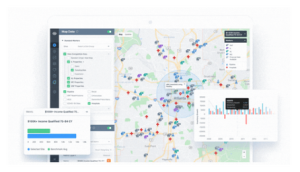BACKGROUND
The FHA / HUD 223(a)7 loan program provides a streamlined refinance option for existing FHA insured loans in order to reduce a project’s debt service burden by lowering the interest rate and extending the amortization period. Qualifying projects stand to further benefit from the credit
enhancement afforded by the FHA / HUD loan insurance program with the same attractive features of the existing FHA-insured loan but with lower debt service payments. Key characteristics of this 223(a)7 loan program include the following:
- Fully amortizing;
- Longer-term / amortization;
- Low-interest rate, fixed for the term of the loan;
Higher leverage; and - Non-recourse.
The following is a detailed discussion on the 223(a)7 loan program.
ELIGIBLE PROPERTIES
Eligible properties include multifamily apartment rental projects, seniors housing, and skilled nursing facilities with existing FHA-insured loans.
To qualify for 223(a)7 loan program, existing market rate, affordable and subsidized multifamily rental housing projects along with seniors housing and skilled nursing facilities need to have an existing FHA-insured loan. In addition, the scope of any proposed or required repairs cannot exceed $1,500 per unit.
BORROWER TYPE
The Owner/Mortgagor entity can be either for-profit or non-profit but must be a single asset entity whose sole asset represents the project under financing consideration.
GUARANTEES
FHA / HUD-insured loans are generally non-recourse. No individual assumes personal liability for payments due under the loan documents or not under its control. However, key principals can be personally liable for retaining project funds or property which it is not entitled to or for authorizing the conveyance, assignment, transfer, pledge, encumbrance, or other disposition of the mortgaged property without prior approval from HUD.
LOAN TERM & AMORTIZATION
The FHA / HUD 223(a)7 loan has a term up to 12 years beyond the maturity of the existing loan being refinanced, not to exceed the original loan term of the existing FHA-insured loan.
INTEREST RATES
Interest rates are determined by market conditions at the time of rate lock. The rate is fixed for the full term of the loan. Typically, rate lock occurs after HUD completes its review of the application and issues a Commitment, and no major hurdles exist that would prevent closing within 6 weeks. Between 2012 and October 2019, average interest rates on 223(a)7 loans ranged from approximately 3.05% to 4.10%, according to HUD published data.
Note: these rates include 223(a)7 loans with higher interest rates charged to secure additional proceeds on the sale of the loan in order to offset the Borrower’s prepayment penalty as detailed below.
EXISTING PREPAYMENT PENALTIES
Under the 223(a)7 loan program, lenders may pay or provide funds for existing prepayment penalties. This is an exception to the general rule prohibiting lenders from paying borrower costs. Under a 223(a)7 refinance, lenders can pay or offset the prepayment penalty on the existing loan
LOAN PARAMETERS
The loan sizing parameters for FHA / HUD 223(a)7 loans are the lower of:
Property Type: Minimum DSCR
Subsidized = 1.05x
All Other Projects = 1.11x
Cash-out refinance transactions are not permitted under this loan program. Subsidized projects are generally defined by HUD as those having greater than 90% units subject to LIHTC restrictions or project-based rental assistance.
LOCKOUT & PREPAYMENT PENALTIES
Lockout and prepayment penalties are negotiable, but best interest rate pricing is typically secured with 10-year call protection (a lockout period and/or prepayment penalties over the 10 years following construction).
For those loans with a prepayment penalty, the 1st year starts at 10% and is reduced 1% per year until year 10.
Sample prepayment penalty language from a Note of a HUD-insured loan. A common prepayment penalty structure is the “10-9-8-7-6-5-4-3-2-1-0” structure where the prepayment penalty is 10% in year 1, followed by a 1% reduction upon each 1-year anniversary so that the prepayment penalty is 0% upon the 10-year anniversary. Shorter call protection may increase the interest rate the FHA Lender is able to offer. For example, borrowers have been quoted a 50-60 basis point interest rate premium for shorter 5-year call protection.
ASSUMPTION
223(a)7 loans are fully assumable, subject to Lender & HUD approval and fees. HUD typically imposes a 0.50% TPA (Transfer of Physical Asset) fee for full ownership transfer transactions. Lender fees may vary but are typically commensurate with its incurred legal and administrative fees.
LENDER FINANCING FEE
Typically, 0.5% – 1.0%. Lender financing fees are determined based on market conditions and the size and complexity of the proposed transaction, subject to HUD limitations. Current HUD regulations permit maximum lender financing fees on 223(a)7 loans up to 2.0% of the loan amount (3.5% for loans below $2 million). Lender financing fees on transactions involving bond financing are permitted up to 4.0% (5.5% for loans below $2 million).
HUD APPLICATION FEE
HUD imposes an application fee of 0.15% of the loan amount to review the application to determine whether the proposed loan qualifies for HUD mortgage insurance. The HUD application fee is due to HUD at application submission. The application fee paid to HUD at application submission equals 0.15% of the loan amount applied for. The final application fee owed to HUD is based on the final loan amount at closing. Any difference between the fee paid at application submission and the fee owed based on the final loan amount is due at closing.
HUD INSPECTION FEE
Not Applicable. HUD does not impose an inspection fee under this loan program, even if repairs are required.
HUD MIP
0.25% annually for Green projects and Broadly Affordable projects,
0.35% annually for Affordable projects, and
0.50% annually for market-rate projects.
The HUD mortgage insurance premium fee (HUD MIP) is a fee charged by HUD for providing a credit enhancement in the form of FHA mortgage insurance which provides access to the advantageous interest rate terms available under the HUD loan program. Presently, the initial and
annual HUD MIP rates imposed by HUD are: 0.25% for Green and Broadly Affordable projects; 0.35% for Affordable projects; and 0.50% for Market Rate projects. Examples of Green projects which qualify for the reduced 0.25% HUD MIP rate include projects that meet industry-recognized
standards for green buildings including ENERGY STAR, National Green Building Standard, U.S. Green Building Council’s LEED-H, and others. Such projects must achieve an ENERGY STAR score of 75 or better using EPA’s Portfolio Manager. Examples of Broadly Affordable Projects which qualify for the reduced 0.25% rate include projects with 90% or more units that are subject to LIHTC restrictions or Section 8 project-based rental assistance. Examples of Affordable projects which qualify for the reduced 0.35% rate include projects with 10-90% of their units subject to Low Income Housing Tax Credit (LIHTC) restrictions or Section 8 project-based rental assistance. Unrestricted, market-rate projects that do not meet HUD green standards are subject to a 0.50% MIP rate.
THIRD-PARTY REPORTS
Capital Needs Assessment (CNA).
The CNA provides an assessment of the property and site condition and identifies required. The CNA provides an assessment of the property and site condition and identifies required immediate and future capital repairs and replacements. The CNA’s conclusions help determine any
required repairs and repair escrow (if completed post-closing), any required supplemental deposit to replacement reserves due at closing, and the new required monthly deposit to replacement reserves thereafter.
HUD considers waivers for projects which completed new construction, substantial rehabilitation, or a prior CNA within the past 5 years.
ESCROWS / RESERVES
- Typical tax and insurance escrows (including MIP);
- Replacement Reserves;
- Repairs identified in the CNA not completed prior to closing
TAX & INSURANCE. HUD requires that the FHA Lender collect and maintain tax and insurance escrows in order to ensure that: (a) there are sufficient funds available to pay real estate taxes; and (b) there are sufficient funds available to pay insurance premiums for insurance coverages as required by the HUD Loan Program. The Lender typically collects an initial deposit at closing and subsequently bills for and collects funds to cover tax and insurance expenses along with each monthly principal and interest payment. The tax and insurance amounts collected at initial closing and each month are based upon the amount necessary to pay all insurance premiums, real estate taxes, and governmental assessments at least thirty days prior to each due date for each year during the term loan.
REPLACEMENT RESERVES. HUD requires that the FHA Lender collect and maintain capital replacement reserves to ensure that there are sufficient funds available to fund capital replacement needs as they come due. Replacement reserves are typically held in escrow by the
Lender in an interest-bearing account with an acceptable financial institution. At closing, the Lender is required to collect an initial deposit to capital replacement reserves if existing replacement reserves are insufficient. Thereafter, the Lender bills for and collects funds for
monthly capital replacement reserve deposits. The minimum HUD required initial and annual deposit is $250 per unit. The actual required initial and monthly replacement reserve deposit can be higher, based on a determination by the Lender and HUD during loan application processing.
Such determination is based on the anticipated levels of funding required to meet anticipated capital replacement needs – based on a Capital Needs Assessment completed during application processing – and the HUD Loan Program requirements.
REPAIRS. At closing, HUD requires that the Lender collect and maintain an escrow for 100% of the Typical tax and insurance escrows (including MIP) Replacement Reserves Repairs identified in the CNA not completed prior to the closing estimated cost to complete required repairs identified in the CNA that are not completed prior to closing, plus a 20% contingency (10% on affordable projects) in case of cost overruns. The repair escrow is released upon completion of required repairs, except for a 2.5% repair estimate holdback for potential latent defects which may be released 15 months following completion of repair work assuming such repair work is in good order.
LABOR STANDARDS
HUD 223(a)7 loan program requirements do not impose any Davis-Bacon prevailing wage requirements.
TIMING
Typically, 3-5 months from engagement to closing. Timeframes may vary significantly, depending on the complexity of the transaction, borrower cooperation, and the volume of loan applications being processed by HUD. HUD published guidance notes that it is in HUD’s interest for projects to be refinanced under 223(a)7; accordingly, HUD’s loan procedures are kept to a minimum and provide flexibility to allow minimal processing.
The 223(a)7 loan application process typically involves the following stages: HUD Application → Closing.
HUD APPLICATION. Given the level of due diligence completed with the original HUD financing, the 223(a)7 loan application is less involved. Typically, there is no appraisal or Phase I ESA requirement, and there are fewer required exhibits. Still, the 223(a)7 loan application requires a CNA (if not eligible to be waived), property financial information, and some credit and due diligence on the project and its key principals. The Lender’s loan underwriting synthesizes all the data and analysis into the required HUD commitment application for mortgage insurance. The Lender’s preparation generally takes between 1-2 weeks from the time all requisite items are provided. HUD’s review can take up to 30 days per its internal requirements, although it often goes longer.
CLOSING. Once HUD has completed its review and is satisfied with the application, HUD will issue its approval in the form of a HUD Commitment for mortgage insurance along with its terms and conditions to close. If acceptable to the parties, the attorneys will be engaged to prepare and review the loan documents and required due diligence. Lender’s counsel will assemble a preclosing package and, upon completion, submit to HUD. HUD will then review the pre-closing submission and, if acceptable, clear the project to close. This process generally takes between 15-submission and, if acceptable, clear the project to close. This process generally takes between 15-45 days.
We hope you find this information helpful. If you have further questions or would simply like to speak with an expert in the field, feel free to Contact Us.






